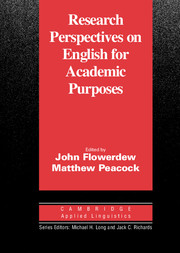Book contents
- Frontmatter
- Contents
- List of contributors
- Series editors' preface
- Preface
- I ISSUES IN ENGLISH FOR ACADEMIC PURPOSES
- II THE ENGLISH FOR ACADEMIC PURPOSES CURRICULUM
- Introduction to Part II
- 11 The EAP curriculum: Issues, methods, and challenges
- 12 Twenty years of needs analyses: Reflections on a personal journey
- 13 The curriculum renewal process in English for academic purposes programmes
- 14 Team-teaching in EAP: Changes and adaptations in the Birmingham approach
- 15 Does the emperor have no clothes? A re-examination of grammar in content-based instruction
- 16 The specialised vocabulary of English for academic purposes
- 17 Language learning strategies and EAP proficiency: Teacher views, student views, and test results
- 18 Issues in EAP test development: What one institution and its history tell us
- 19 Teaching writing for academic purposes
- 20 Reading academic English: Carrying learners across the lexical threshold
- 21 Incorporating reading into EAP writing courses
- 22 The development of EAP oral discussion ability
- 23 Second language lecture comprehension research in naturalistic controlled conditions
- 24 Designing tasks for developing study competence and study skills in English
- 25 Promoting EAP learner autonomy in a second language university context
- References
- Index
11 - The EAP curriculum: Issues, methods, and challenges
Published online by Cambridge University Press: 05 October 2012
- Frontmatter
- Contents
- List of contributors
- Series editors' preface
- Preface
- I ISSUES IN ENGLISH FOR ACADEMIC PURPOSES
- II THE ENGLISH FOR ACADEMIC PURPOSES CURRICULUM
- Introduction to Part II
- 11 The EAP curriculum: Issues, methods, and challenges
- 12 Twenty years of needs analyses: Reflections on a personal journey
- 13 The curriculum renewal process in English for academic purposes programmes
- 14 Team-teaching in EAP: Changes and adaptations in the Birmingham approach
- 15 Does the emperor have no clothes? A re-examination of grammar in content-based instruction
- 16 The specialised vocabulary of English for academic purposes
- 17 Language learning strategies and EAP proficiency: Teacher views, student views, and test results
- 18 Issues in EAP test development: What one institution and its history tell us
- 19 Teaching writing for academic purposes
- 20 Reading academic English: Carrying learners across the lexical threshold
- 21 Incorporating reading into EAP writing courses
- 22 The development of EAP oral discussion ability
- 23 Second language lecture comprehension research in naturalistic controlled conditions
- 24 Designing tasks for developing study competence and study skills in English
- 25 Promoting EAP learner autonomy in a second language university context
- References
- Index
Summary
English language teaching can be classified into two main branches, English for General Purposes (EGP) and English for Specific Purposes (ESP) (Strevens, 1988a; Hutchinson and Waters, 1987). Within English for Specific Purposes there are again two principal branches, English for Academic Purposes (EAP) and English for Occupational Purposes (EOP). However, within ESP, EAP tends to dominate, certainly in terms of research and research-based application.
The now widely accepted recognition of EAP as a separate and distinct discipline from EGP, on the one hand, and EOP, on the other (albeit with much overlapping), has made urgent the continuing search for the best approach to the design, implementation and evaluation of the EAP course. The teaching and learning of EAP presents its own unique challenges, problems, opportunities, failings and successes, and course and curriculum designers have to accept and meet those challenges and opportunities. One vital step in this process is producing a comprehensive description of the unique needs and wishes of the EAP student; another is shaping a detailed description of the nature of the EAP teaching and learning process; a third critical step in designing the EAP curriculum is accepting that the methodologies and approaches valid in any other area of ESL are not necessarily the most appropriate for EAP. The needs and wishes of EAP learners are distinct and clearly identifiable from those of EGP learners, as is the EAP learning context, and the EAP course designer must investigate and try to fufil those needs and wishes within the context of the relevant EAP course.
- Type
- Chapter
- Information
- Research Perspectives on English for Academic Purposes , pp. 177 - 194Publisher: Cambridge University PressPrint publication year: 2001
- 26
- Cited by

